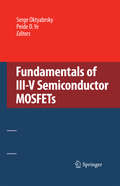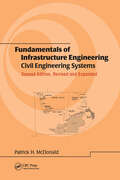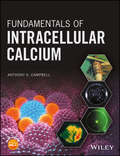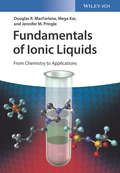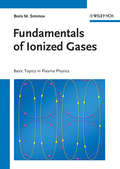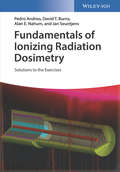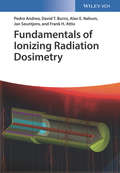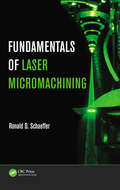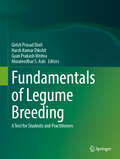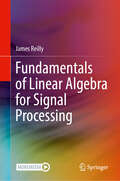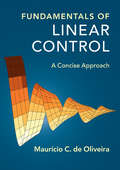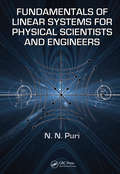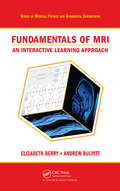- Table View
- List View
Fundamentals of III-V Semiconductor MOSFETs
by Peide Ye Serge OktyabrskyFundamentals of III-V Semiconductor MOSFETs presents the fundamentals and current status of research of compound semiconductor metal-oxide-semiconductor field-effect transistors (MOSFETs) that are envisioned as a future replacement of silicon in digital circuits. The material covered begins with a review of specific properties of III-V semiconductors and available technologies making them attractive to MOSFET technology, such as band-engineered heterostructures, effect of strain, nanoscale control during epitaxial growth. Due to the lack of thermodynamically stable native oxides on III-V's (such as SiO2 on Si), high-k oxides are the natural choice of dielectrics for III-V MOSFETs. The key challenge of the III-V MOSFET technology is a high-quality, thermodynamically stable gate dielectric that passivates the interface states, similar to SiO2 on Si. Several chapters give a detailed description of materials science and electronic behavior of various dielectrics and related interfaces, as well as physics of fabricated devices and MOSFET fabrication technologies. Topics also include recent progress and understanding of various materials systems; specific issues for electrical measurement of gate stacks and FETs with low and wide bandgap channels and high interface trap density; possible paths of integration of different semiconductor materials on Si platform.
Fundamentals of In Vivo Magnetic Resonance: Spin Physics, Relaxation Theory, and Contrast Mechanisms
by Daniel M. Spielman Keshav DattaFundamentals of In Vivo Magnetic Resonance Authoritative reference explaining why and how the most important, radiation-free technique for elucidating tissue properties in the body works In Vivo Magnetic Resonance helps readers develop an understanding of the fundamental physical processes that take place inside the body that can be probed by magnetic resonance imaging (MRI) and magnetic resonance spectroscopy (MRS), uniquely bridging the gap between the physics of magnetic resonance (MR) image formation and the in vivo processes that influence the detected signals, thereby equipping the reader with the mathematical tools essential to study the spin interactions leading to various contrast mechanisms. With a focus on clinical relevance, this book equips readers with practical knowledge that can be directly applied in medical settings, enabling informed decision-making and advancements in the field of medical imaging. The material arises from the lecture notes for a Stanford University Department of Radiology course taught for over 15 years. Aided by clever illustrations, the book takes a step-by-step approach to explain complex concepts in a comprehensible manner. Readers can test their understanding by working on approximately 60 sample problems. Written by two highly qualified authors with significant experience in the field, In Vivo Magnetic Resonance includes information on: The fundamental imaging equations of MRI Quantum elements of magnetic resonance, including linear vector spaces, Dirac notation, Hilbert Space, Liouville Space, and associated mathematical concepts Nuclear spins, covering external and internal interactions, chemical shifts, dipolar coupling, J-coupling, the spin density operator, and the product operator formalism In vivo MR spectroscopy methods MR relaxation theory and the underlying sources of image contrast accessible via modern clinical MR imaging techniques With comprehensive yet accessible coverage of the subject and a wealth of learning resources included throughout, In Vivo Magnetic Resonance is an ideal text for graduate students in the fields of physics, biophysics, biomedical physics, and materials science, along with lecturers seeking classroom aids.
Fundamentals of Incompressible Fluid Flow
by V. BabuThis highly informative and carefully presented book offers a comprehensive overview of the fundamentals of incompressible fluid flow. The textbook focuses on foundational topics to more complex subjects such as the derivation of Navier-Stokes equations, perturbation solutions, inviscid outer and inner solutions, turbulent flows, etc. The author has included end-of-chapter problems and worked examples to augment learning and self-testing. This book will be a useful reference for students in the area of mechanical and aerospace engineering.
Fundamentals of Industrial Catalytic Processes
by Calvin H. Bartholomew Robert J. FarrautoCatalysis is central to the chemical industry, as it is directly or involved in the production of almost all useful chemical products. In this book the authors, present the definitive account of industrial catalytic processes. Throughout Fundamentals of Industrial Catalytic Processes the information is illustrated with many case studies and problems. This book is valuable to anyone wanting a clear account of industrial catalytic processes, but is particularly useful to industrial and academic chemists and engineers and graduate working on catalysis. This book also: Covers fundamentals of catalytic processes, including chemistry, catalyst preparation, properties and reaction engineering. Addresses heterogeneous catalytic processes employed by industry. Provides detailed data on existing catalysts and catalytic reactions, process design and chemical engineering. Covers catalysts used in fuel cells.
Fundamentals of Industrial Chemistry
by John A. TyrellThis book discusses the connectivity between major chemicals, showing how a chemical is made along with why and some of the business considerations. The book helps smooth a student's transition to industry and assists current professionals who need to understand the larger picture of industrial chemistry principles and practices. The book:Addresses a wide scope of content, emphasizing the business and polymer / pharmaceutical / agricultural aspects of industrial chemistryCovers patenting, experimental design, and systematic optimization of experimentsWritten by an author with extensive industrial experience but who is now a university professor, making him uniquely positioned to present this materialHas problems at the end of chapters and a separate solution manual available for adopting professorsPuts chemical industry topics in context and ties together many of the principles chemistry majors learn across more specific courses
Fundamentals of Industrial Problem Solving: A Practitioner's Guide
by Carla Schmidt David M. Jacobson Dana Livingston J.P. Chauvel Zdravko I. Stefanov Eldad Herceg Sunil Kumar Chaudhary Christopher Paul ChristensonTeaches Readers How to Apply a Structured Problem-Solving Methodology for Industrial Fields Based on Sound Scientific Principles As modern industrial processes have become increasingly complex, complicated multi-factor problems have emerged. These complex problems end up costing companies millions of dollars every day. Existing problem-solving techniques are only effective to a certain point. This book provides a solution to a myriad of industrial problems by using first principles and rigorous hypothesis testing. Key topics covered within the work include: How to use the latest research, advanced modeling, big data mining, analytical testing, and many other techniques to systematically create and test hypotheses surrounding why a process is malfunctioning How to use scenario development to frame a team’s understanding of why a process is malfunctioning How to approach today’s lack of experienced industrial workers, whose failure to approach problem solving from first fundamentals are causing myriad of inefficiencies in industry How to use multiple methodologies together with an emphasis on first principles and mechanistic math modeling as a basis to industrial problem solving Engineers of any discipline working in both research and development of manufacturing environments, along with professionals in any industrial discipline looking to reduce costs will be able to use this work to both understand and pragmatically solve the pressing issues we see in today’s industrial market.
Fundamentals of Infrastructure Engineering: Civil Engineering Systems, Second Edition, (Civil and Environmental Engineering)
by Patrick H. McDonaldBased on the author's extensive experience, this book presents recent advances in systems theory and methodology for infrastructure engineering. It highlights modern approaches to the analysis, design, construction, implementation, management, and maintenance of large-scale infrastructure systems and projects, including transportation and water res
Fundamentals of Inhomogeneous Fluids
by Douglas HendersonA monograph examining recent progress in the field of inhomogeneous fluids, focusing on the theoretical - as well as experimental - techniques used. It presents the comprehensive theory of first-order phase transitions, including melting, and contains numerous figures, tables and display equations.;The contributors treat such subjects as: exact sum rules for inhomogenous fluids, explaining density functional and integral equation methods; exact solutions for two-dimensional homogeneous and inhomogeneous plasmas; current advances in the theory of interfacial electrochemistry; wetting experiments and the theory of wetting; freezing, with an emphasis on quantum systems and homogeneous nucleation in liquid-vapour and solid-liquid transitions; self-organizing liquids as well as kinetic phenomena in inhomogeneous fluids, using a modified Enskog theory.;Featuring over 1000 bibliographic citations, this volume is aimed at physical, surface, colloid and surfactant chemists; also physicists, electrochemists and graduate-level students in these disciplines.
Fundamentals of Innovative Sustainable Homes Design and Construction (The Urban Book Series)
by Avi FriedmanThis book offers ideas and practices on contemporary design concepts and illustrates them with plans and photographs of outstanding examples. Current planning and design modes of dwellings and neighborhoods are facing challenges of philosophy and form. Past approaches no longer sustain new demands and require innovative thinking. The need for a new outlook is propelled by fundamental changes that touch upon environmental, economic and social aspects. The depletion of non-renewable natural resources and climate change are a few of the environmental challenges. Increasing costs of material, labor, land and infrastructure have posed economic challenges with affordability being paramount among them. Social challenges are also drawing the attention of designers, builders and homeowners. Walkable communities, aging in place and multigenerational living are some of the concepts considered. In addition, live-work environments have become part of the economic reality for those who wish to work from home—which has become possible through digital advances. The text would be of interest to scholars working in: architecture, urban planning, and construction.
Fundamentals of Intracellular Calcium
by Anthony K. CampbellThe definitive text on the key component for cell functions—intracellular calcium This comprehensive book reveals the evidence for intracellular calcium as a universal switch in all animal, plant, fungal and microbial cells. It shows how the components required for calcium signaling are named and classified; covers the technology that has been developed to study intracellular calcium; describes how calcium is regulated inside cells and how it works to trigger an event; explains the role of intracellular calcium in disease, cell injury, and cell death; reveals how many drugs work through the calcium signaling system; and demonstrates how intracellular calcium is involved in the action of many natural toxins. The book also illustrates how the intracellular calcium signaling system has evolved over millions of years, showing why it was crucial to the origin of life. Additionally, the book promotes the importance of the molecular variation upon which the intracellular calcium signalling system depends. Featuring more than 100 figures (including detailed chemical structures as well as pictures of key pioneers in the field), a bibliography of some 1000 references, and a detailed subject index, this definitive work provides a unique source of scholarship for teachers and researchers in the biomedical sciences and beyond. Emphasizes two key scientific principles—the first to show how intracellular Ca2+ acts as a switch, to activate a wide range of cellular events, and the second demonstrating how an analogue mechanism can be superimposed on such a process Written by an internationally recognized expert in the field Filled with images and references to facilitate learning Fundamentals of Intracellular Calcium is an all-important text for post-graduate students and researchers working in biomedicine and biochemistry. It is also essential for undergraduate lecturers and their students in physiology, medicine, pharmacy, and the biosciences.
Fundamentals of Invertebrate Palaeontology
by Sreepat JainThis book provides practical morphological information, together with detailed illustrations and concise texts explaining each entry. The book details the morphological characters of each organism, providing fundamental information for palaeontologists and palaeobiologists alike. Each chapter starts with a brief introduction and goes on to describe the organism's morphology in detail, followed by a brief note on classification and lastly illustrated examples of stratigraphically important organisms through time along with their major distinguishing characters. The book includes over 3000 clearly labelled, hand-drawn and classroom-friendly illustrations of over 1200 species.
Fundamentals of Invertebrate Palaeontology: Microfossils (Springer Geology)
by Sreepat JainThis book provides practical morphological information, together with detailed illustrations and brief explanatory texts. Each chapter starts with a brief introduction, and goes on to describe the respective organism’s morphology in detail through numerous illustrations. This is followed by a brief note on its classification, and concludes with illustrated examples of stratigraphically important organisms through time with their major distinguishing characteristics. Featuring over 2500 clearly labelled, hand-drawn and classroom-friendly illustrations, the book offers a fundamental resource for budding palaeontologists, petroleum geologists and palaeobiologists.
Fundamentals of Ionic Liquids: From Chemistry to Applications
by Douglas R. Macfarlane Mega Kar Jennifer M. PringleWritten by experts who have been part of this field since its beginnings in both research and academia, this textbook introduces readers to this evolving topic and the broad range of applications that are being explored. The book begins by examining what it is that defines ionic liquids and what sets them apart from other materials. Chapters describe the various types of ionic liquids and the different techniques used to synthesize them, as well as their properties and some of the methods used in their measurement. Further chapters delve into synthetic and electrochemical applications and their broad use as "Green" solvents. Final chapters examine important applications in a wide variety of contexts, including such devices as solar cells and batteries, electrochemistry, and biotechnology. The result is a must-have resource for any researcher beginning to work in this growing field, including senior undergraduates and postgraduates.
Fundamentals of Ionized Gases: Basic Topics in Plasma Physics
by Boris M. SmirnovA comprehensive and readily accessible work for studying the physics of ionized gases, based on "Physics of Ionized Gases". The focus remains on fundamentals rather than on the details required for interesting but difficult applications, such as magnetic confinement fusion, or the phenomena that occur with extremely high-intensity short-pulse lasers. However, this new work benefits from much rearranging of the subject matter within each topic, resulting in a more coherent structure. There are also some significant additions, many of which relate to clusters, while other enlarged sections include plasmas in the atmosphere and their applications. In each case, the emphasis is on a clear and unified understanding of the basic physics that underlies all plasma phenomena. Thus, there are chapters on plasma behavior from the viewpoint of atomic and molecular physics, as well as on the macroscopic phenomena involved in physical kinetics of plasmas and the transport of radiation and of charged particles within plasmas. With this grounding in the fundamental physics of plasmas, the notoriously difficult subjects of nonlinear phenomena and of instabilities in plasmas can then be treated with comprehensive clarity. The work is rounded off with appendices containing information and data of great importance and relevance that are not easily found in other books. Valuable reading for graduate and PhD physics students, and a reference for researchers in low-temperature ionized gases-plasma processing, edge region fusion plasma physics, and atmospheric plasmas.
Fundamentals of Ionizing Radiation Dosimetry: Solutions to Exercises
by Alan E. Nahum David T. Burns Jan Seuntjens Pedro AndreoFosters a thorough understand of radiation dosimetry concepts: detailed solutions to the exercises in the textbook "Fundamentals of Ionizing Radiation Dosimetry"!
Fundamentals of Ionizing Radiation Dosimetry: Textbook And Solutions
by Alan E. Nahum David T. Burns Frank Herbert Attix Jan Seuntjens Pedro AndreoA new, comprehensively updated edition of the acclaimed textbook by F.H. Attix (Introduction to Radiological Physics and Radiation Dosimetry) taking into account the substantial developments in dosimetry since its first edition. This monograph covers charged and uncharged particle interactions at a level consistent with the advanced use of the Monte Carlo method in dosimetry; radiation quantities, macroscopic behaviour and the characterization of radiation fields and beams are covered in detail. A number of chapters include addenda presenting derivations and discussions that offer new insight into established dosimetric principles and concepts. The theoretical aspects of dosimetry are given in the comprehensive chapter on cavity theory, followed by the description of primary measurement standards, ionization chambers, chemical dosimeters and solid state detectors. Chapters on applications include reference dosimetry for standard and small fields in radiotherapy, diagnostic radiology and interventional procedures, dosimetry of unsealed and sealed radionuclide sources, and neutron beam dosimetry. The topics are presented in a logical, easy-to-follow sequence and the text is supplemented by numerous illustrative diagrams, tables and appendices. For senior undergraduate- or graduate-level students and professionals.
Fundamentals of Kinematics and Dynamics of Machines and Mechanisms
by Oleg VinogradovThe study of the kinematics and dynamics of machines lies at the very core of a mechanical engineering background. Although tremendous advances have been made in the computational and design tools now available, little has changed in the way the subject is presented, both in the classroom and in professional references.Fundamentals of Kinematics and Dynamics of Machines and Mechanisms brings the subject alive and current. The author's careful integration of Mathematica software gives readers a chance to perform symbolic analysis, to plot the results, and most importantly, to animate the motion. They get to "play" with the mechanism parameters and immediately see their effects. The downloadable resources contain Mathematica-based programs for suggested design projects.As useful as Mathematica is, however, a tool should not interfere with but enhance one's grasp of the concepts and the development of analytical skills. The author ensures this with his emphasis on the understanding and application of basic theoretical principles, unified approach to the analysis of planar mechanisms, and introduction to vibrations and rotordynamics.
Fundamentals of Laboratory Animal Science
by Enqi Liu and Jianglin FanLaboratory animals are becoming increasingly important for biomedical research. It is said that approximately 70% of biomedical research is associated with the use of experimental animals. Laboratory animal research not only expands our knowledge of science, but also greatly improves human and animal health. The field of laboratory animal science is ever-growing and changing as new experimental techniques are developed and new animal models are created. It is essential to know not only the biological features of each laboratory animal but also how to use and care for them responsibly in order to perform high-quality experiments. Courses in beginning Laboratory Animal Science are starting to be offered in many universities throughout the world. However, a practical introductory textbook that contains state-of-the-art techniques is still lacking. Fundamentals of Laboratory Animal Science provides comprehensive information on the principles and practices of using laboratory animals for biomedical research. Each individual chapter focuses on a key sub-discipline of laboratory animal science: animal welfare and best humane care practices in the laboratory; the quality control of laboratory animals; the anatomy, physiology, and husbandry of commonly used species; the principles of creating and using animal models for studying human diseases; practical techniques used for laboratory animal experiments; experimental design; and animal experimentation management. Knowledge of this broad spectrum of concepts and skills will ensure research goes smoothly while greatly reducing animal pain and distress. Well-illustrated and thoroughly referenced, this book will serve not only as a standard textbook but also as a handy guide for veterinarians, researchers, animal care staff, administrators, and other professionals who are involved in laboratory animal science.
Fundamentals of Laser Micromachining
by Ronald SchaefferDue to their flexible and efficient capabilities, lasers are often used over more traditional machining technologies, such as mechanical drilling and chemical etching, in manufacturing a wide variety of products, from medical implants, gyroscopes, and drug delivery catheters to aircraft engines, printed circuit boards, and fuel cells. Fundamentals
Fundamentals of Legume Breeding: A Text for Students and Practitioners
by Harsh Kumar Dikshit Gyan Prakash Mishra Muraleedhar S. Aski Girish Prasad DixitMany advances have been made in plant breeding during the last few decades, which has added an altogether new dimension to legume breeding. This book explains theoretical as well as latest advances in plant-breeding practices, tools and techniques, including developments in genomics. It describes crop origin, reproduction, biology, genetic principles, and other developments applicable in plant-breeding. It also covers descriptions of well-established and novel plant-breeding techniques, and discussions on crop-specific, plant-breeding objectives with emphasis on market-oriented variety development. The chapters describe focused breeding procedures for the major legumes as per their economic importance. This book provides knowledge of modern breeding tools for developing climate-resilient and micronutrient-rich varieties of different pulse crops. The chapters also describe both conventional and non-conventional breeding approaches adopted by the plant breeders for each crop. This book serves as a reference for the post-graduate, plant-breeding students as well as plant breeders.
Fundamentals of Linear Algebra for Signal Processing
by James ReillySignal processing is ubiquitous in many fields of science and engineering. This textbook is tailored specifically for graduate students and presents linear algebra, which is requisite knowledge in these fields, in a form explicitly targeted to signal processing and related disciplines. Written by an experienced author with over 35 years of expertise in signal processing research and teaching, this book provides the necessary foundation in a focused and accessible manner, offering a practical approach to linear algebra without sacrificing rigor. Emphasis is placed on a deeper conceptualization of material specific to signal processing so students may more readily adapt this knowledge to actual problems in the field. Since other emerging areas, such as machine learning, are closely related to signal processing, the book also provides the necessary background in this discipline. The book includes many examples and problems relevant to signal processing, offering explanations and insights that are difficult to find elsewhere. Fundamentals of Linear Algebra for Signal Processing will allow students to master the essential knowledge of linear algebra for signal processing. It is also an essential guide for researchers and practitioners in biomedical, electrical, chemical engineering, and related disciplines.
Fundamentals of Linear Control: A Concise Approach
by Maurício C. De OliveiraTaking a different approach from standard thousand-page reference-style control textbooks, Fundamentals of Linear Control provides a concise yet comprehensive introduction to the analysis and design of feedback control systems in fewer than 400 pages. The text focuses on classical methods for dynamic linear systems in the frequency domain. The treatment is, however, modern and the reader is kept aware of contemporary tools and techniques, such as state space methods and robust and nonlinear control. Featuring fully worked design examples, richly illustrated chapters, and an extensive set of homework problems and examples spanning across the text for gradual challenge and perspective, this textbook is an excellent choice for senior-level courses in systems and control or as a complementary reference in introductory graduate level courses. The text is designed to appeal to a broad audience of engineers and scientists interested in learning the main ideas behind feedback control theory. Provides a comprehensive yet concise introduction to the analysis and design of feedback control systems, with the required content presented in less than 400 pages, versus the typical thousand-page standard control textbooks presently available. Features fully worked examples and richly illustrated chapters, complemented by an extensive set of homework problems with activities in MATLAB®, allowing students to gain valuable hands-on experience by solving select problems which span across chapters. Offers a complete teaching package on the companion website that include all MATLAB® scripts to generate all figures and tables in the book and a complete solutions manual.
Fundamentals of Linear Systems for Physical Scientists and Engineers
by N.N. PuriThanks to the advent of inexpensive computing, it is possible to analyze, compute, and develop results that were unthinkable in the '60s. Control systems, telecommunications, robotics, speech, vision, and digital signal processing are but a few examples of computing applications. While there are many excellent resources available that focus on one
Fundamentals of Low Dimensional Magnets (Series in Materials Science and Engineering)
by Sanjay Mishra Ram K. Gupta Tuan Anh NguyenA low-dimensional magnet is a key to the next generation of electronic devices. In some respects, low-dimensional magnets refer to nanomagnets (nanostructured magnets) or single-molecule magnets (molecular nanomagnets). They also include the group of magnetic nanoparticles, which have been widely used in biomedicine, technology, industries, and environmental remediation.Low-dimensional magnetic materials can be used effectively in the future in powerful computers (hard drives, magnetic random-access memory, ultra-low power consumption switches, etc.). The properties of these materials largely depend on the doping level, phase, defects, and morphology. This book covers various nanomagnets and magnetic materials. The basic concepts, various synthetic approaches, characterizations, and mathematical understanding of nanomaterials are provided. Some fundamental applications of 1D, 2D, and 3D materials are covered.This book provides the fundamentals of low-dimensional magnets along with synthesis, theories, structure-property relations, and applications of ferromagnetic nanomaterials. This book broadens our fundamental understanding of ferromagnetism and mechanisms for realization and advancement in devices with improved energy efficiency and high storage capacity.
Fundamentals of MRI: An Interactive Learning Approach (Series in Medical Physics and Biomedical Engineering)
by Elizabeth Berry Andrew J. BulpittFundamentals of MRI: An Interactive Learning Approach explores the physical principles that underpin the technique of magnetic resonance imaging (MRI).After covering background mathematics, physics, and digital imaging, the book presents fundamental physical principles, including magnetization and rotating reference frame. It describes how relaxation mechanisms help predict tissue contrast and how an MR signal is localized to a selected slice through the body. The text then focuses on frequency and phase encoding. It also explores the spin-echo sequence, its scan parameters, and additional imaging sequences, such as inversion recovery and gradient echo.The authors enhance the learning experience with practical materials. Along with questions, exercises, and solutions, they include ten interactive programs on the accompanying downloadable resources. These programs not only allow concepts to be clearly demonstrated and further developed, but also provide an opportunity to engage in the learning process through guided exercises.By providing a solid, hands-on foundation in the physics of MRI, this textbook helps students gain confidence with core concepts before they move on to further study or practical training.
